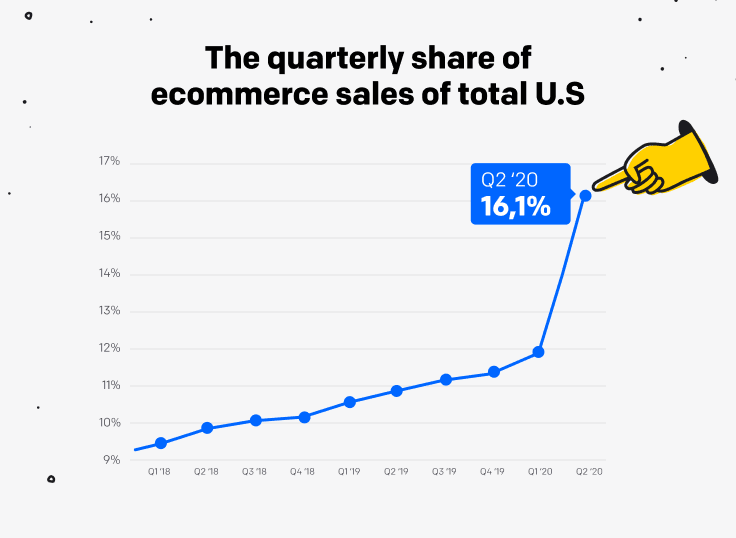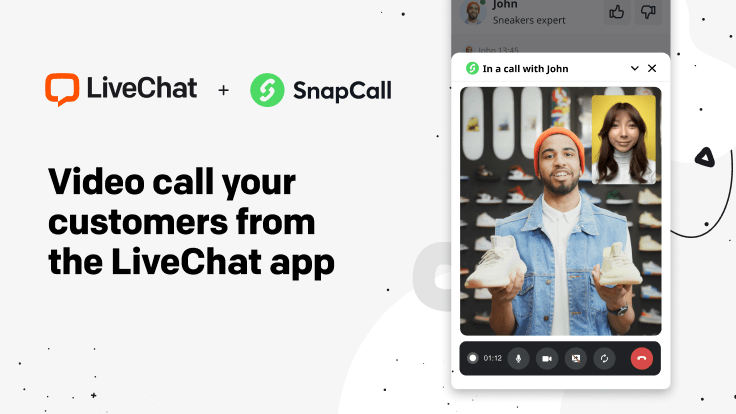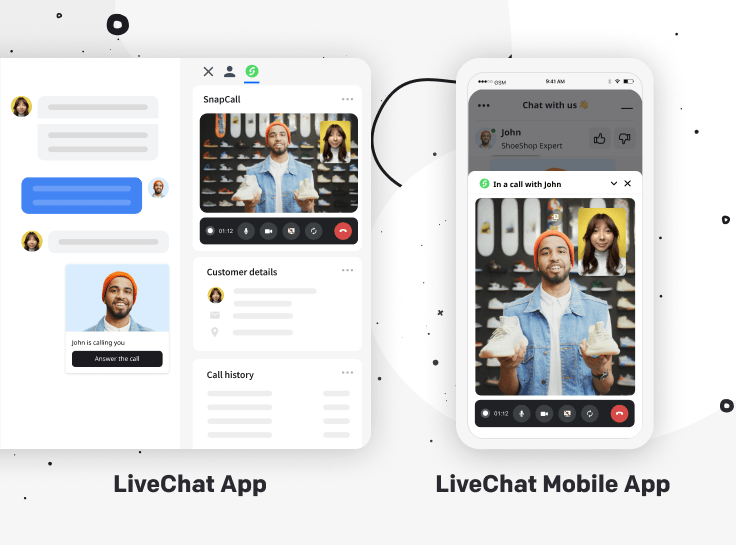Showing top 0 results 0 results found
Showing top 0 results 0 results found

For some, the COVID-19 pandemic and its consequences haven’t turned out all that bad. How so? Take a look at shopping. Sure, the way we buy stuff has been transforming over the past decade or so, with more and more people shifting towards online purchases. Ecommerce has been growing exponentially, even before March 2020, but it was the global pandemic that catapulted revenue to levels never before seen by online businesses. All of this gave birth to a new trend — video shopping — and it’s safe to say that it’s here to stay.
Let’s talk about video calls first
When I read that the first video call happened in 1927, I couldn’t believe my eyes. You mean to tell me people could do this more than half a century before the internet was invented? Obviously, the first video call didn’t resemble the video calls of today, but it’s still difficult to wrap my brain around this information. Anyway, the first video call ever between the then-president of AT&T Walter Gifford, who received a call from Herbert Hoover, was a breakthrough.
Things weren’t all that rosy for a long time after that, though. The great, novel idea turned out to be a flop for a couple of reasons. One was that not many people actually wanted to use the Picturephone created by AT&T, mostly because of its steep price tag — equivalent to $1,000 today. As a consequence, those who bought the device didn’t really have many people to talk to. Another reason sounds all too familiar to those of us that’ve been videoconferencing for the last year and a half — people simply didn’t want to be seen. Now, ask yourself, how often do you turn your camera off and try to transform a video call into a simple voice call?
After decades of unsuccessfully scaling video calling, it finally gained traction in the ‘90s, and it happened by accident. Many of us can’t imagine life without coffee. Neither did computer scientists at the University of Cambridge in England. Coffee was something they couldn’t live without, but not all scientists had equal access to it. Dr. Quentin Stafford-Fraser explains, "One of the things that's very, very important in computer science research is a regular and dependable flow of caffeine."
The problem was that the coffee pot was placed in the main computer lab, which only housed a few of the researchers. Those who worked in other labs and different floors of the building would often turn up at the coffee room — dubbed the Trojan room — only to find that the pot was empty. Now, imagine going to the kitchen in your office in desperate need of a cup of coffee only to find that all the coffee had gone.
To avoid similar situations, the scientists set up a camera that monitored the coffee pot and sent images showing coffee levels to the internal computer network. On November 22, 1993, the scientists were going about their business. Since Dr. Martyn Johnson wasn’t connected to the internal computer network and couldn’t see the images of the coffee pot, he decided to write a script that would let him closely monitor the coffee levels, just as his colleagues did. Little did he know that he created the first-ever webcam that could be accessed by anyone with an internet connection. But I digress.
In 2003 we got to know Skype. Former Yahoo! employees launched WhatsApp in 2009. Then, Apple introduced FaceTime in 2010, and Facebook released Messenger in 2011. People around the world have become more and more familiar with video calls, but I wonder how many of us predicted that they were going to play such a vital role so quickly in the way we shop. Fast forward to March 2020 and consumers had to reinvent the way they go shopping, and businesses had to reinvent how to sell their products and services before going bankrupt.
How we changed the way we shop
With lockdowns imposed all over the world in the first half of 2020, people who stayed at home to stop the spread of the virus still had to shop. Whether we’re talking about groceries, clothes, or cosmetics, we bought them mostly online for a long time. This led to significant changes and shifts between in-store and online purchases.
In October 2020, we reported the following:
Offline spending in the U.S. was abnormally low in Q2 2020. The $41.23 billion decline in in-store sales was evened out by online purchases, though. When we took a closer look at ecommerce sales alone, it turned out that consumers spent over $200 billion with U.S. retailers, moving up 44.4% from $138.96 billion for the same quarter in 2019. That means that more than 20% of total retail spendings in Q2 in the U.S. came from online purchases. In other words, out of every $5 spent, more than $1 was spent online. This brings us to the most significant increase in ecommerce penetration when it hit 20.8%, compared to 14.7% in Q2 2019. To put that into perspective, no other quarter-over-quarter or year-over-year has increased ecommerce penetration by more than two percentage points.
This called for a more personal way to buy online. People longed for something that would at least resemble the in-store experience, communicating with sales assistants, and trying out items just to see what they look like on an actual person. The quarterly share of ecommerce sales of total U.S. retail sales backed the need for such solutions even more:

At LiveChat, we noticed a significant increase in the number of customers that were in desperate need of staying in touch with their customers. While live chat is one of the most effective ways of communicating with people in need of customer service or advice, it turned out that with the integration with SnapCall, we could help our customers a little bit more. We got as close to an in-store experience as we possibly could.

What’s video shopping?
Video shopping is all about video calling a shop assistant so you can see a product you want to buy in real life. Well, sort of. Obviously, you won’t be able to see if whatever you want to buy fits you like a glove, but the option to video call a shop assistant and asking them for product demonstrations makes the whole experience a lot more personalized.
Now, if you already use LiveChat and you want to add video shopping to the customer experience you provide to your customers, you need to integrate your LiveChat license with SnapCall. With live product demonstrations, your customers will be much more likely to buy. Without leaving the house, they can see whether this new dress or pair of jeans they want to buy will be a good fit for them.
Just so you know, you don’t have to run an ecommerce business to reap the benefits of integrating LiveChat with SnapCall. Apart from video calls, you can also make instant voice calls by inviting customers with a single click. If it’s difficult to explain something to a customer over a chat, voice call, or even video call, you also have the ability to share your screen right from the chat window, with no additional plugins. Choose whether you want to share your entire screen, one window, or a specific tab, and walk your customers through what they need to do at a given moment.
The SnapCall integration is now also available in the LiveChat mobile app
While you’ve been reading this article, until now you might’ve thought, “Right, but how am I gonna do a product demonstration with a laptop camera?” And let’s face it, a laptop or desktop computer is not the handiest device to use to display your products. You don’t have to worry about this any longer.

With the SnapCall integration now available in the LiveChat mobile app, you can quickly jump on a video call on your phone and demonstrate your product in your store, showcase a hotel room to a potential guest, or take soon-to-be newlyweds on a virtual tour around a wedding venue.
Ecommerce sales have significantly slowed down in 2021. Since more and more people have gotten vaccinated, they’ve been flocking back to brick-and-mortar stores and spending the money that they spent online last year there. Still, consumers’ online spending during Q2 2021 increased over the same three months in 2020. Despite a slower rate, ecommerce is growing and it’ll probably continue to do so for a long time. You’ll need a way to make the most of this, and inviting your customers to go video shopping is one of the best investments you can make.
Get a glimpse into the future of business communication with digital natives.
Get the FREE report








Comments